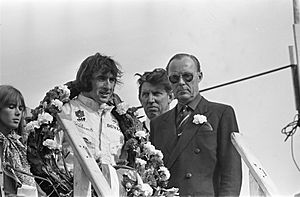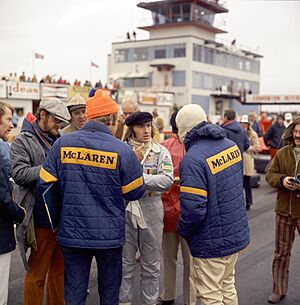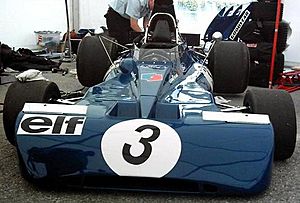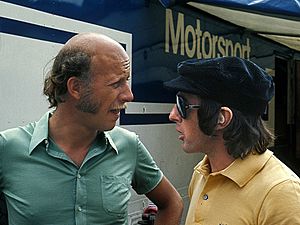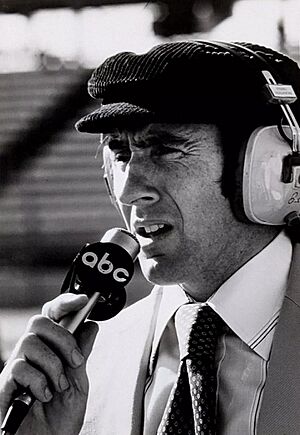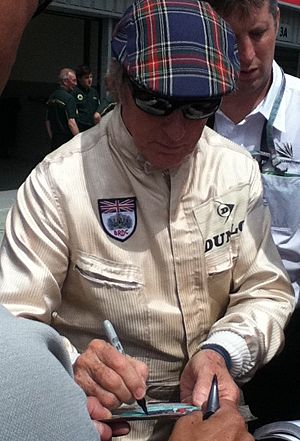Jackie Stewart facts for kids
Quick facts for kids
Jackie Stewart
|
|
|---|---|
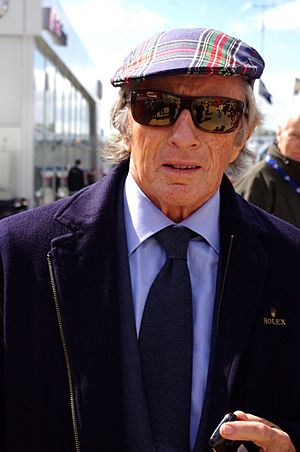
Stewart at the 2014 6 Hours of Silverstone
|
|
| Born |
John Young Stewart
11 June 1939 Milton, West Dunbartonshire, Scotland
|
| Spouse(s) |
Helen McGregor
(m. 1962) |
| Children | 2, including Paul |
| Relatives | Jimmy Stewart (brother) |
| Formula One World Championship career | |
| Nationality | |
| Active years | 1965–1973 |
| Teams | BRM, Tyrrell |
| Entries | 100 (99 starts) |
| Championships | 3 (1969, 1971, 1973) |
| Wins | 27 |
| Podiums | 43 |
| Career points | 359 (360) |
| Pole positions | 17 |
| Fastest laps | 15 |
| First entry | 1965 South African Grand Prix |
| First win | 1965 Italian Grand Prix |
| Last win | 1973 German Grand Prix |
| Last entry | 1973 United States Grand Prix |
Sir Jackie Stewart (born 11 June 1939) is a famous British former racing driver from Scotland. He raced in Formula One from 1965 to 1973. People called him "the Flying Scot" because he was so fast. Jackie Stewart won three Formula One World Drivers' Championship titles with the Tyrrell team. When he stopped racing, he held the records for the most wins (27) and podium finishes (43).
Stewart was a runner-up twice during his nine seasons in Formula One. He was the only British driver with three championships until Lewis Hamilton matched him in 2015. Outside of Formula One, he almost won the Indianapolis 500 in 1966. He also raced in the Can-Am series in 1970 and 1971. From 1997 to 1999, he ran the Stewart Grand Prix F1 team with his son, Paul. After racing, Stewart became a sports commentator for TV. He covered the Indianapolis 500 for over ten years. He was known for his clear Scottish accent. Stewart also appeared in TV commercials for companies like Ford Motor Company.
Jackie Stewart worked hard to make motor racing safer. He pushed for better medical care and safer tracks. After John Surtees passed away in 2017, Stewart became the last living Formula One World Champion from the 1960s. He is also the oldest living Grand Prix winner.
| Top - 0-9 A B C D E F G H I J K L M N O P Q R S T U V W X Y Z |
Early Life and First Steps in Racing
Growing Up in Scotland
Jackie Stewart was born in Milton, a village near Glasgow, Scotland. His family owned a successful car dealership. His father was an amateur motorcycle racer. His older brother, Jimmy, was also a well-known local racing driver. Jimmy even competed in the 1953 British Grand Prix.
Jackie went to primary school in Dumbarton. At age 12, he moved to Dumbarton Academy. He had learning difficulties because of undiagnosed dyslexia. At the time, dyslexia was not well understood. Teachers and other students often made fun of him. Jackie left school at 16 and started working as a mechanic in his father's garage. He was not diagnosed with dyslexia until 1980. This happened when his oldest son, Mark, was diagnosed. Jackie realized he had similar symptoms and got tested himself. He was 41 years old when he finally understood his learning challenges. He once said that if you have dyslexia and find something you are good at, you work harder at it.
A Champion Shooter
When he was 13, Jackie won a clay pigeon shooting competition. He became a prize-winning member of the Scottish shooting team. He competed in the UK and other countries. He won championships in British, Irish, Welsh, and Scottish skeet shooting. He also won the "Coupe de Nations" European championship twice. He tried out for the British team for the 1960 Summer Olympics. He finished third, just missing a spot.
Starting His Driving Career
Jackie's first car was a light green Austin A30. He bought it for £375 just before his 17th birthday. He saved the money from tips at his family's garage. A customer, Barry Filer, offered Jackie a chance to test some of his cars. In 1961, Filer gave him a Marcos car. Jackie won four races with it. He also drove Filer's Aston DB4GT once.
In 1962, Jackie tested a Jaguar E-type to see if he could be a professional driver. He matched the times of a famous driver, Roy Salvadori. He won two races in the E-type. Then, David Murray offered him a spot with Ecurie Ecosse. He won races with them too. By 1963, he had 14 wins.
Joining Ken Tyrrell
In 1964, Jackie signed with Ecurie Ecosse again. Ken Tyrrell ran a Formula Junior team for Cooper Car Company. He heard about Jackie from a track manager. Tyrrell called Jackie's brother, Jimmy, to see if Jackie wanted a tryout. Jackie went to Goodwood for the test. He drove a new Formula Three car that Bruce McLaren was testing. Jackie quickly drove faster than McLaren. Tyrrell offered Jackie a place on his team.
Racing Career Highlights
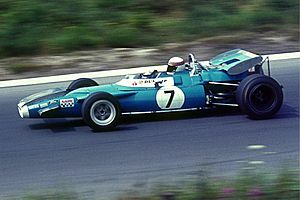
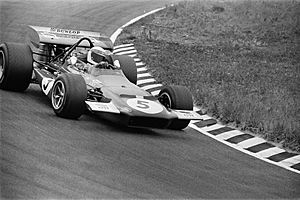
Junior Racing Success
In 1964, Stewart raced in Formula Three (F3) for Tyrrell. His first race was in the rain at Snetterton. He dominated, leading by 25 seconds in just two laps. He won by 44 seconds. Soon after, he was offered a Formula One (F1) spot with Cooper. But he chose to stay with Tyrrell to gain more experience. He won the F3 championship that year. He then joined the Lotus Formula Two (F2) team. In his F2 debut, he finished second.
Racing with BRM (1965–1967)
Stewart signed with BRM for 1965, joining Graham Hill. His first F1 race was in December 1964. He filled in for an injured Jim Clark. He started from pole position and won the second heat. In his first official F1 World Championship race in South Africa, he finished sixth. His first big win was at the BRDC International Trophy. Before the year ended, he won his first World Championship race at Monza. He finished his first season in third place in the World Drivers' Championship.
In 1966, Stewart won the 1966 Tasman Series. But 1966 was a tough year for him in F1. The BRM cars were not reliable. He did win the 1966 Monaco Grand Prix. The most important event that year was his crash at the Belgian Grand Prix. This accident made him start his campaign for better safety in F1. He also almost won the 1966 Indianapolis 500 on his first try. He was leading by a full lap with eight laps to go. But a mechanical problem stopped him. Even so, he was named "Rookie of the Year."
BRM's luck did not get better in 1967. Stewart finished no higher than second place in F1. He had to drive one-handed in one race to keep the car in gear. In F2, he won several races.
Matra and Tyrrell Years (1968–1973)
For 1968, Stewart moved to Tyrrell's Matra International team. He drove a Matra MS10 car. He played a big part in managing the team. He helped get more money from sponsors and worked with engine and tire suppliers. People said he was a new kind of F1 driver. He won races in the rain at Zandvoort and the Nürburgring. He won the Nürburgring race by four minutes! He also won at Watkins Glen. But his car broke down in Mexico City, and he lost the championship to Hill.
In 1969, Stewart was amazing. He won by huge margins in many races. He won by over two laps at Montjuïc and a minute ahead at Clermont-Ferrand. He also won by more than a lap at Silverstone. With more wins, Stewart became world champion. He was the only driver to win the championship in a car built by a French company until 2005. He is still the only driver to win in a car built in France by a private team. That year, Stewart led at least one lap in every Grand Prix. No other driver has done that.
For 1970, Matra wanted to use their own engines. But Tyrrell and Stewart wanted to keep using the Ford Cosworth engine. So, Tyrrell decided to build his own car. While it was being built, Stewart raced a March car. He won two races with it. The new Tyrrell 001 car showed promise.
Stewart won the F1 World Championship again in 1971. He drove the Tyrrell 003 car. He won races in Spain, Monaco, France, Britain, Germany, and Canada. He also raced a full season in Can-Am. The constant racing and travel caused him health issues. He won the 1971 championship even though he was sick. He crossed the Atlantic Ocean 186 times for media events in the United States.
In 1972, he missed a race due to health problems. He won the Argentine, French, U.S., and Canadian Grands Prix. He finished second in the championship to Emerson Fittipaldi. Stewart also raced a Ford Capri in the European Touring Car Championship. In 1972, he received the OBE award.
Stewart had decided to retire before the 1973 season. He felt tired from the constant travel and racing. He also saw many of his friends die in racing accidents. He said his wife, Helen, counted 57 friends who had died. He won races in South Africa, Belgium, Monaco, and the Netherlands. His last win, his 27th, was at the Nürburgring. This set a new record for wins. He said winning at Nürburgring gave him the most satisfaction, but he was always scared there. He would look back at his home, unsure if he would return.
His teammate, François Cevert, died in a crash during practice for the 1973 United States Grand Prix. Because of this, Stewart retired one race earlier than planned. He missed what would have been his 100th Grand Prix. He had already won the Drivers' Championship two races earlier.
Stewart held the record for most F1 wins (27) for 14 years. Alain Prost broke it in 1987. He held the record for most wins by a British F1 driver for 19 years. Nigel Mansell broke it in 1992. Until 2015, Stewart was the only British driver with three championships. Lewis Hamilton broke this record. When John Surtees died in 2017, Stewart became the last living F1 World Champion from the 1960s. He also became the oldest living F1 winner after Tony Brooks passed away in 2022.
Racing Safety Advocate
In 1966, Stewart crashed at Spa-Francorchamps in heavy rain. He hit a telephone pole and a shed. His leg was pinned by the steering column. Fuel spilled into the car. There were no track crews or proper tools to help him. Fellow drivers Graham Hill and Bob Bondurant rescued him. There were no doctors or medical facilities at the track. Stewart was put in a pickup truck until an ambulance arrived. The ambulance driver then got lost on the way to the hospital. Finally, a private jet flew Stewart back to the UK for treatment.
After this crash, Stewart became a strong supporter of auto racing safety. He said his most important legacy would be in safety. When he started racing, safety measures were terrible.
Stewart worked with Louis Stanley (BRM team boss) to improve emergency services and safety barriers. He pointed out that there were no barriers in front of the pits. Fuel was stored in open containers. A car could easily crash into the pits. As a temporary solution, Stewart hired his own doctor for all his races. He even taped a spanner to his car's steering shaft in case he needed to free himself again.
Stewart pushed for drivers to wear seat belts and full-face helmets. These are now standard in racing. He also urged track owners to make their tracks safer. He organized driver boycotts of races at Spa-Francorchamps in 1969, the Nürburgring in 1970, and Zandvoort in 1972. He insisted on better barriers, run-off areas, fire crews, and medical facilities. Some drivers and reporters thought these safety changes made the sport less exciting. Track owners worried about the extra costs. Stewart later said he would have been more popular if he had just agreed with everyone. But he might have been dead.
Consultant Work
In 1964, Stewart started an important partnership with the Ford Motor Company. This collaboration lasted 25 years. It had a big impact on both Stewart's career and the car industry.
As a consultant for Ford, Stewart trained their engineers. He helped them find ways to make cars better. He used his vast racing experience to give valuable advice. He knew a lot about high-performance cars and racing challenges. This helped Ford improve their car designs and safety.
Through this work, Stewart helped make Ford's vehicles safer and perform better. He also showed his dedication to improving car technology. His influence helped create more advanced and safer cars for everyone.
Television Commentator
Working for ABC and NBC
From 1971 to 1986, Stewart was a TV commentator. He covered F1, NASCAR, and Indy car races, including the Indianapolis 500. He also hosted some shows. He was a commentator for the Luge and Equestrian events on ABC's Wide World of Sports. He was known for his smart analysis, Scottish accent, and fast talking. The main commentator, Jim McKay, once joked that Stewart spoke almost as fast as he drove. In his book, Stewart shared that he used notes for broadcasts because his dyslexia made it hard to read from a teleprompter.
Stewart often talked about driver safety on TV. He criticized drivers who were careless with fireproof clothing. In the 1977 Daytona 500, a driver got burned. Stewart said drivers should always wear flame-resistant underwear. He also mentioned some disagreements with ABC Sports producer Roone Arledge. Stewart was doing commercials for Ford, and some aired on Wide World of Sports. This led to him leaving ABC in 1986.
Later, Stewart covered CART Indy car races for NBC SportsWorld starting in 1987. He only covered road course and street races for NBC.
Other TV Appearances
Stewart also worked on Australian and Canadian TV from the late 1980s to the mid-1990s. He sometimes appeared with Murray Walker as a co-commentator on the BBC's F1 coverage.
Team Owner
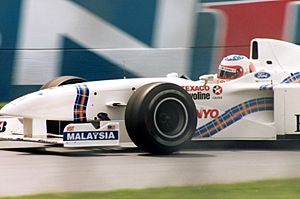
In 1997, Stewart returned to Formula One as a team owner. He partnered with his son, Paul, to create Stewart Grand Prix. This team grew from Paul Stewart Racing, which raced in lower categories. As the official Ford team, their first race was the 1997 Australian Grand Prix. Their only success that first year was a second-place finish for Rubens Barrichello at the rainy Monaco Grand Prix. The next year, 1998, was less successful.
After Ford bought Cosworth in 1998, the team decided to build a new engine for 1999. The SF3 car was very competitive that season. The team won one race at the European Grand Prix with Johnny Herbert. Barrichello also finished third three times. Ford later bought the team, and it became Jaguar Racing in 2000. This team then became Red Bull Racing in 2005. Stewart also works as a sports consultant for the Royal Bank of Scotland.
Awards and Recognition
Jackie Stewart was nicknamed "The Flying Scot." In 1973, Sports Illustrated magazine gave him their "Sportsman of the Year" award. He is the only auto racer to have won this title. That same year, he also won the BBC Television's "Sports Personality of the Year" award. He was also named ABC's Wide World of Sports Athlete of the Year.
In 1990, he was added to the International Motorsports Hall of Fame. He received honorary doctorates from Heriot-Watt University in 1996 and Cranfield University in 1998.
Stewart was featured on the TV show This Is Your Life in 1970. In 1971, he was made an Officer of the Order of the British Empire (OBE). In 2001, he received a knighthood. Both honors were for his contributions to motor racing. In 2002, he became a founding patron and first member of the Scottish Sports Hall of Fame. In 2008, he received an honorary Doctor of Science degree from the University of St Andrews.
On 26 June 2009, Stewart was given the Freedom of West Dunbartonshire. This is a special honor in his hometown. In 2010, he was named a founding member of Motor Sport magazine's Hall of Fame. In 2020, The Economist magazine ranked him as the 4th best driver of all time. Other mathematical models also consistently place him among the greatest Formula One drivers ever.
Other Appearances
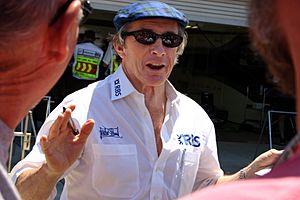
Stewart appeared in the 1966 movie Grand Prix. He did all the driving scenes for actor Brian Bedford, who played Scott Stoddard. This was because Bedford did not know how to drive. Stewart was the main subject of the 1972 film Weekend of a Champion, produced by Roman Polanski. The film followed him during a race weekend at the 1971 Monaco Grand Prix.
In 1979, George Harrison, a good friend of Stewart's, released a song called "Faster". It was a tribute to Stewart and other Formula One drivers. In the music video, Stewart played Harrison's limousine driver.
He appeared in a 1983 commercial for the Vectrex game console with his son Mark. Stewart also wrote the introduction for the book The Centenary of the Car 1885–1985. He took part in Prince Edward's 1987 charity TV special, The Grand Knockout Tournament.
Stewart was in a special video for the new Ford Mondeo car in 1993. He was also featured in the music video for the 2000 song "Supreme" by Robbie Williams. Stewart appeared in several UPS commercials in 2002 and 2003. He was a consultant for Dale Jarrett, trying to convince him to "race the Big Brown truck." He also appeared on the UK car show Top Gear as a driving instructor. He was interviewed in Martin Scorsese's 2011 documentary about George Harrison. In 2018, Stewart appeared in US commercials for Heineken beer. He refused a beer, saying "I'm still driving," before driving away in a Jaguar F-Type.
Helmet Design
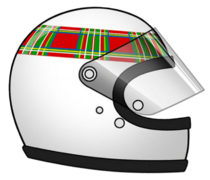
Jackie Stewart's helmet was white. It had the red, green, blue, white, and yellow Royal Stewart tartan pattern around the top. This tartan is a traditional Scottish design.
Personal Life
Stewart married his childhood sweetheart, Helen McGregor, in 1962. They have two sons, Paul and Mark. Paul is a former racing driver who ran Paul Stewart Racing with his father. Mark is a film and television producer. From 1969 to 1997, Jackie and Helen lived in Switzerland.
Stewart dictated his autobiography called Winning Is Not Enough because of his dyslexia. In 2014, Helen McGregor Stewart was diagnosed with frontotemporal dementia. This is a type of dementia that affects memory and behavior.
In 2018, Stewart started a charity called Race Against Dementia. By that time, Helen had limited short-term memory and trouble moving around. She needed care all the time. Stewart believes that using Formula 1's technology and creative thinking could help find solutions for dementia sooner. By 2025, Helen's behavior and language changes had become worse. She sometimes did not recognize Jackie. Stewart's charity is funding research for a blood test. This test aims to detect non-genetic frontotemporal dementia years before it would normally be diagnosed.
Career Summary
| Season | Series | Team | Races | Wins | Poles | F/laps | Podiums | Points | Position |
|---|---|---|---|---|---|---|---|---|---|
| 1964 | British Formula Three | Tyrrell Racing Organisation | 8 | 7 | 4 | 7 | 7 | 54 | 1st |
| French Formula Three | ? | ? | ? | ? | ? | 0 | NC | ||
| Trophées de France | Team Lotus | 3 | 0 | 0 | 0 | 2 | 12 | 5th | |
| British Formula Two | 2 | 1 | 0 | 0 | 2 | 0 | NC | ||
| British Saloon Car Championship – Class B | Red Rose Motors | 2 | 0 | 0 | 0 | 0 | 4 | 6th | |
| 1965 | Formula One | Owen Racing Organisation | 10 | 1 | 0 | 0 | 5 | 33 | 3rd |
| British Formula Two | Tyrrell Racing Organisation | 4 | 0 | 0 | 1 | 1 | 6 | 8th | |
| Trophées de France | 3 | 0 | 1 | 0 | 0 | 4 | 9th | ||
| 24 Hours of Le Mans | Owen Racing Organisation | 1 | 0 | 0 | 0 | 0 | N/A | 10th | |
| 1966 | Formula One | Owen Racing Organisation | 8 | 1 | 0 | 0 | 1 | 14 | 7th |
| Tasman Series | 8 | 4 | 3 | 5 | 5 | 45 | 1st | ||
| Trophées de France | Tyrrell Racing Organisation | 4 | 0 | 0 | 0 | 0 | 8 | 5th | |
| Can-Am | Mecom Racing Enterprises | 2 | 0 | 0 | 0 | 0 | 0 | NC | |
| USAC Championship Car | 1 | 0 | 0 | 0 | 0 | 0 | NC | ||
| British Formula Two | Tyrrell Racing Organisation | 1 | 0 | 0 | 0 | 0 | 0 | NC | |
| 1967 | Formula One | Owen Racing Organisation | 11 | 0 | 0 | 0 | 2 | 10 | 9th |
| Tasman Series | 6 | 2 | 3 | 1 | 2 | 18 | 2nd | ||
| European Formula Two | Tyrrell Racing Organisation | 5 | 1 | 1 | 1 | 3 | 0 | NC‡ | |
| USAC Championship Car | Mecom Racing Enterprises | 1 | 0 | 0 | 0 | 0 | 0 | NC | |
| 1968 | Formula One | Matra International | 10 | 3 | 0 | 2 | 4 | 36 | 2nd |
| 1969 | Formula One | Matra International | 11 | 6 | 2 | 5 | 7 | 63 | 1st |
| European Formula Two | 4 | 2 | 0 | 2 | 4 | 0 | NC‡ | ||
| 1970 | Formula One | Tyrrell Racing Organisation | 13 | 1 | 4 | 0 | 4 | 25 | 5th |
| British Saloon Car Championship – Class C | Team Broadspeed | 1 | 0 | 1 | 1 | 0 | 0 | NC | |
| Can-Am | Chaparral Cars Inc. | 1 | 0 | 0 | 1 | 0 | 0 | NC | |
| 1971 | Formula One | Elf Team Tyrrell | 11 | 6 | 6 | 3 | 7 | 62 | 1st |
| Can-Am | Carl Haas Racing | 10 | 2 | 2 | 1 | 4 | 76 | 3rd | |
| 1972 | Formula One | Elf Team Tyrrell | 11 | 4 | 2 | 4 | 5 | 45 | 2nd |
| 1973 | Formula One | Elf Team Tyrrell | 14 | 5 | 3 | 1 | 8 | 71 | 1st |
| European Touring Car Championship – Div. II | Ford Köln | 3 | 0 | 1 | 0 | 0 | 0 | NC |
‡ Graded drivers not eligible for European Formula Two Championship points
Images for kids
See also
 In Spanish: Jackie Stewart para niños
In Spanish: Jackie Stewart para niños


